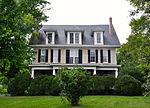Dyer Observatory

The Dyer Observatory, also known as the Arthur J. Dyer Observatory, is an astronomical observatory owned and operated by Vanderbilt University. Built in 1953, it is located in Nashville, Tennessee, and is the only university facility not located on the main campus in Nashville. The observatory is named after Arthur J. Dyer, who paid for the observatory's 24-foot (7.3 m)-wide dome, and houses a 24-inch (610 mm) reflecting telescope named for astronomer Carl Seyfert. Today, the observatory primarily serves as a teaching tool; its mission is to interest the public in the fields of astronomy, science and engineering. The observatory was listed on the National Register of Historic Places on March 6, 2009.
Excerpt from the Wikipedia article Dyer Observatory (License: CC BY-SA 3.0, Authors, Images).Dyer Observatory
Oman Drive, Nashville-Davidson
Geographical coordinates (GPS) Address Website External links Nearby Places Show on map
Geographical coordinates (GPS)
| Latitude | Longitude |
|---|---|
| N 36.052222222222 ° | E -86.805 ° |
Address
Vanderbilt Dyer Observatory
Oman Drive 1000
37027 Nashville-Davidson
Tennessee, United States
Open on Google Maps







